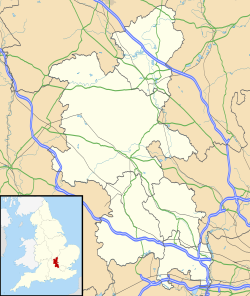Church of England
The oldest parts of the Church of England parish church of the Assumption of the blesséd Virgin Mary are Norman. [5] The nave was built first, and the north aisle and its two-bay arcade were added in about 1190. [5] [7] One Norman window survives in the west wall of the north aisle. [5]
In the middle of the 13th century the chancel was rebuilt with Early English Gothic lancet windows and piscina. [7] Two of these lancets survive; one each in the south and north walls. [7] The south aisle was added at the same time, and its surviving Early English details are a piscina [9] and a lancet west window. [5] The south aisle's two-bay arcade was originally in the Transitional style between Norman and Early English. [9] Only its east arch survives in this form, as in about 1360 its west arch was rebuilt. [5] At the same time both aisles were widened, which is why the west window of the south aisle is now off-centre. [7] In the 14th century in the chancel the lancet window on the south side was extended downwards to form a sedile and an ogeed and crocketted tomb recess was inserted in the north wall. [7] The chancel east window is Perpendicular Gothic. [9] The nave has a clerestory whose roof timbers are early 16th-century. [7] Its tie-beams are moulded and have spandrels with cinquefoil tracery. [7] The second stage of the west tower has a plain two-light window that is also 16th-century. [7]
In 1863 the church was restored under the direction of the Oxford Diocesan Architect, G.E. Street. Street had the gable-roofed west tower rebuilt and a south porch added. [7] He added a vestry and organ-chamber adjoining the north side of the chancel and east end of the north aisle. [7] He also added a south chapel, inserting an arch between the chapel and south aisle and a two-bay arcade between the chapel and the chancel. [7] Street re-used the windows that were removed from where the new arches were inserted: re-using and restoring the 14th-century east window from the south aisle as the east window of the chapel, and re-using the two windows from the south wall of the chancel as the chapel's two south windows. [7]
In the chancel are two monumental brasses. On the north side is an early 15th-century 2-foot (0.6 m) brass of a priest wearing his Mass vestments. [5] [7] On the south side are late 15th-century 9-inch (230 mm) brass figures of Thomas Grene in civilian dress with his first and second wives, Joan and Agnes. [5] [7] The church has three 17th-century wall-mounted stone monuments. The most notable is a Jacobean one on the east wall of the north aisle, which has kneeling effigies of Simon Heynes (died 1628) and his wife with their baby, framed by Corinthian columns. [5] [7]
The stained glass in the east window of the south chapel was made by Thomas Willement in 1851. [5] That in the east window of the chancel was made by Michael O'Connor in 1870. [5]
The west tower has two early 17th-century bells, both cast by Robert Atton [3] of Buckingham. The tenor was cast in 1625 and the treble in 1626. [3] In 1913 the treble was reported to be "badly cracked". [7]
The church is a Grade II* listed building. [9]
The advowson has been attached to the manor since at least the 13th century. Westminster Abbey has held the advowson since Edward I bestowed the manor upon the Abbey in 1292. [3]
The parish of the Assumption is part of the Benefice of West Buckingham, along with the parishes of Biddlesden, Shalstone, Tingewick, Water Stratford and Westbury. [11]






